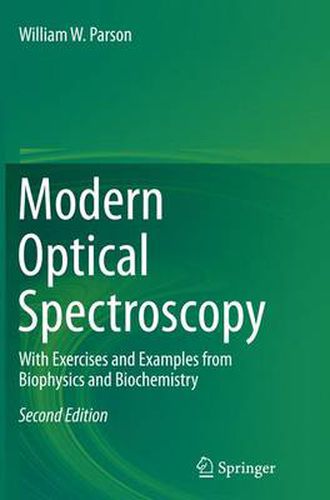Readings Newsletter
Become a Readings Member to make your shopping experience even easier.
Sign in or sign up for free!
You’re not far away from qualifying for FREE standard shipping within Australia
You’ve qualified for FREE standard shipping within Australia
The cart is loading…






This title is printed to order. This book may have been self-published. If so, we cannot guarantee the quality of the content. In the main most books will have gone through the editing process however some may not. We therefore suggest that you be aware of this before ordering this book. If in doubt check either the author or publisher’s details as we are unable to accept any returns unless they are faulty. Please contact us if you have any questions.
This textbook offers clear explanations of optical spectroscopic phenomena and shows how spectroscopic techniques are used in modern molecular and cellular biophysics and biochemistry. The topics covered include electronic and vibrational absorption, fluorescence, resonance energy transfer, exciton interactions, circular dichroism, coherence and dephasing, ultrafast pump-probe and photon-echo spectroscopy, single-molecule and fluorescence-correlation spectroscopy, Raman scattering, and multiphoton absorption. This revised and updated edition provides expanded discussions of quantum optics, metal-ligand charge-transfer transitions, entropy changes during photoexcitation, electron transfer from excited molecules, normal-mode calculations, vibrational Stark effects, studies of fast processes by resonance energy transfer in single molecules, and two-dimensional electronic and vibrational spectroscopy.
The explanations are sufficiently thorough and detailed to be useful for researchers and graduate students and advanced undergraduates in chemistry, biochemistry and biophysics. They are based on time-dependent quantum mechanics, but are developed from first principles with a clarity that makes them accessible to readers with little prior training in this field. Extra topics and highlights are featured in special boxes throughout the text. The author also provides helpful exercises for each chapter.
$9.00 standard shipping within Australia
FREE standard shipping within Australia for orders over $100.00
Express & International shipping calculated at checkout
This title is printed to order. This book may have been self-published. If so, we cannot guarantee the quality of the content. In the main most books will have gone through the editing process however some may not. We therefore suggest that you be aware of this before ordering this book. If in doubt check either the author or publisher’s details as we are unable to accept any returns unless they are faulty. Please contact us if you have any questions.
This textbook offers clear explanations of optical spectroscopic phenomena and shows how spectroscopic techniques are used in modern molecular and cellular biophysics and biochemistry. The topics covered include electronic and vibrational absorption, fluorescence, resonance energy transfer, exciton interactions, circular dichroism, coherence and dephasing, ultrafast pump-probe and photon-echo spectroscopy, single-molecule and fluorescence-correlation spectroscopy, Raman scattering, and multiphoton absorption. This revised and updated edition provides expanded discussions of quantum optics, metal-ligand charge-transfer transitions, entropy changes during photoexcitation, electron transfer from excited molecules, normal-mode calculations, vibrational Stark effects, studies of fast processes by resonance energy transfer in single molecules, and two-dimensional electronic and vibrational spectroscopy.
The explanations are sufficiently thorough and detailed to be useful for researchers and graduate students and advanced undergraduates in chemistry, biochemistry and biophysics. They are based on time-dependent quantum mechanics, but are developed from first principles with a clarity that makes them accessible to readers with little prior training in this field. Extra topics and highlights are featured in special boxes throughout the text. The author also provides helpful exercises for each chapter.